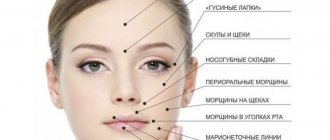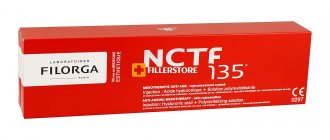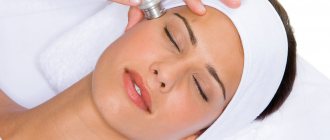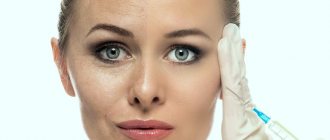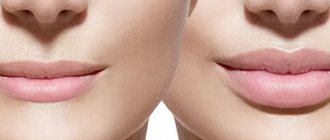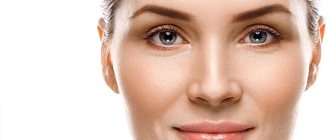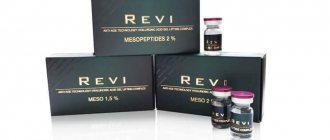Fractional mesotherapy is a modern method of skin rejuvenation, which involves the injection of useful drugs into the structure of the skin. Cocktails for fractional mesotherapy are usually absolutely safe for a girl, however, it is important to pay attention to their choice and features of use in order to avoid complications.
Free radicals and oxidative stress
It is now recognized that oxidative damage to various macromolecules (nucleic acids, proteins, lipids) is the main factor that causes aging of the body and, in particular, the skin.
With excessive accumulation of reactive oxygen species - free radicals with the greatest damaging ability - in skin cells and tissues, damage occurs and, in the literal sense, shortening of cell life. Oxidation is nothing more than the transfer of an electron from an atom of one substance to an atom of another, which is an oxidizing agent. The oxidizing agent, having accepted an electron, is reduced. Oxygen is the main oxidizing agent in nature, but its free radical active forms have an even stronger oxidizing effect. Free radicals are atoms and molecules with an unpaired electron that are highly reactive. They are extremely active in chemical reactions because they have free space for an electron, which they try to “take away” from other substances. If this is successful, the reduced radical becomes inactive, but the oxidized (deprived of an electron) substance becomes an aggressive radical. As a result, previously inert substances begin to actively enter into chemical reactions.
For example, in oxidized DNA, even two parts of one strand can become radicals. Damage in DNA molecules causes death or, even worse, cancerous degeneration of cells.
Free radicals appear as a by-product of the reduction of molecular oxygen to water, which occurs both during the normal respiratory cycle in mitochondria and as a result of the aggressive influence of exogenous factors (UV radiation, radioactive radiation, etc.) and substances (pro-oxidants). Radical forms of oxygen (free radicals) and, above all, superoxide anion and hydroxide radical, having free space for an electron, can be oxidizing agents (the first is weak, the second is very strong). Reactions involving radicals in the body are usually called free radical oxidation. When these reactions are over-activated, oxidative stress occurs.
Purpose of application
Fractional mesotherapy is a minimally invasive cosmetic procedure that involves the subcutaneous injection of special compounds that saturate the skin with beneficial substances and awaken natural metabolic processes.
For fractional mesotherapy, a special device similar to a felt-tip pen is used. It has a nozzle containing a large number of thin needles, which create small punctures in the skin. Through these punctures, the selected meso-cocktail penetrates into it.
Cocktails for fractional facial mesotherapy can eliminate the following problems:
- Flabbiness, dullness of the skin;
- Pigmentation;
- Enlarged pores;
- Acne, post-acne;
- Swelling;
- Dark circles and bags under the eyes;
- Scars;
- Wrinkles.
The lifting effect is most pronounced after mesotherapy. Visually, the skin becomes more youthful, elastic and toned, and minor cosmetic defects are eliminated.
However, keep in mind that to achieve the desired result you will have to complete a full course consisting of 8-15 sessions. The exact number of visits is prescribed by a cosmetologist, taking into account the initial condition of the skin, the effectiveness of the meso-cocktail and the effect you want to achieve.
Causes of Oxidative Stress
The main reasons leading to the activation of free radical oxidation in tissues:
- reducing the intake of exogenous antioxidants (tocopherol, ascorbic acid, bioflavonoids, etc.) into the body;
- stress of various origins;
- entry into the body of pro-oxidants (pesticides, oxidizing drugs, photochemical products of smog, etc.);
- excess consumption of fats and carbohydrates
- if they are not spent enough;
- hypokinesia;
- influence of physical factors (UV radiation, electromagnetic field, etc.);
- age-related decrease in the activity of antioxidant enzymes;
- congenital enzymopathies of antioxidant enzymes.
Lipid peroxidation is one of the main mechanisms of cell damage
Lipid oxidation is called peroxidation because its products are various peroxides, including hydrogen peroxide. According to this mechanism, primarily unsaturated fatty acids that are part of cell membranes are oxidized. This is a series of chain reactions in which the product of one reaction is a catalyst for the next, and the number of free radicals as a result increases like an avalanche. Lipid peroxidation products accumulate and can cause cell death by destroying its membrane lipids. But the main danger of lipid peroxidation is that aggressive lipid peroxides are easily converted into new radicals, their number increases exponentially, they react with all substances that come in their way, and these can be lipids, proteins, and DNA.
The rate of lipid peroxidation is influenced by various external conditions and chemical compounds, which are usually divided into pro-oxidants (increasing the processes of peroxidation) and antioxidants (inhibiting peroxidation).
Compositions of drugs
Most often, meso-cocktails include basic complexes of beneficial substances that are quickly absorbed in the skin and saturate the epithelial cells.
Mesococktail components:
- Hyaluronic acid.
- Vitamins.
- Minerals.
- Oils.
- Phospholipids.
- Organic acids.
- Animal and plant extracts.
When independently selecting a drug for fractional mesotherapy, pay attention to its safety. It must be hypoallergenic and not contain aggressive, toxic components that could lead to skin irritation.
Consequences of free radical reactions
Activation of free radical oxidation, primarily lipid peroxidation, is a universal reaction of the body to external influences of a very different nature. The radicals formed in this case can participate in physiological reactions of the body, such as the breakdown of worn-out protein molecules and phospholipids, the synthesis of lipid bioregulators (prostaglandins, leukotrienes, thromboxanes), and redox signaling processes. Free radical oxidation can be a link in various physiological processes - irritability and arousal, hormone biosynthesis, cell division and differentiation, nonspecific immune response. In a healthy cell and a normally functioning body, there is a balance between free radical and antioxidant reactions.
Factors regulating the intensity of lipid peroxidation | |
| Activating | Braking |
| Hyperoxygenation. | Enzymes of the antioxidant system. |
| Ionizing radiation. | Nutritional factors. |
| Violations of the structure of the cell membrane. | Sufficient intake of tocopherol, selenium, sulfur-containing amino acids (sources of thio groups), other compounds with thio groups, vitamins with antioxidant properties (vitamin C, rutin). |
| Activation of phagocytosis. | |
| State of stress. | |
| Hyperlipidemia. | |
| Excess carbohydrates in food. | |
| Age-related decrease in enzyme activity. | |
If this balance shifts towards the activation of free radical oxidation, and one’s own antioxidants cannot compensate for it, oxidative stress develops. Depending on the degree of activation of oxidative reactions, the final result can be different - from a temporary increase in membrane permeability to cell necrosis. Peroxidation syndrome includes membrane damage, inactivation or transformation of enzymes, inhibition of cell division, and accumulation of inert polymers such as lipofuscin.
Manifestations of oxidative stress
So, the consequence of lipid peroxidation is damage to macromolecules and membranes. This leads to disruption of the barrier and other functions of cell membranes, to the uncoupling of the processes of oxidation and phosphorylation on mitochondrial membranes. Energy deficiency affects all processes, including proliferation, cell differentiation, and the synthesis of various substances. Not only the cells of all layers of the skin suffer, but also the intercellular substance. Damage to enzyme proteins leads to disruption of metabolism in the cell and intercellular space, but cellular enzymes damaged by free radicals can no longer fully control chemical transformations in cells. The natural conformation of protein molecules and the functional interaction of proteins with each other are disrupted. Oxidized proteins begin to respond incorrectly to intracellular signals, and their errors become dangerous for cellular metabolism. Moreover, these processes occur in the cell even with a slight accumulation of free radicals.
Collagen molecules oxidized by free radicals, themselves turning into active radicals, can bind to each other, forming dimers. “Cross-linked” collagen becomes less elastic, and the accumulation of collagen dimers leads to skin aging and the appearance of wrinkles. In addition, the increasing number of intermolecular bonds increases the content of collagen, which is resistant to the action of enzymes. It has now been established that lipid peroxidation and other types of free radical reactions are involved in the pathogenesis of most diseases (including infectious ones) and the formation of aesthetic skin defects. And their role in premature aging of the skin, in the processes of photoaging and carcinogenesis has been convincingly proven. Under conditions of photo-oxidative stress, active oxygen radicals inhibit fibrillogenesis processes, promote collagen fragmentation and the formation of additional cross-links, disrupt the structure and function of the intercellular matrix, and damage the vascular endothelium. Damage to the nuclear structures of the cell causes the growth of tumor cells.
The manifestations of skin damage from free radicals and oxidative stress vary and, of course, depend on the strength, timing of exposure and the nature of the negative factors. This may be dry skin, its increased sensitivity, a tendency to inflammatory reactions, hyperkeratosis, hyperpigmentation, wrinkles, telangiectasia and even various neoplasms.
Contraindications
Mesotherapy is always subject to health restrictions, since it involves a violation of the integrity of the skin. Despite the relative safety of the technology, this factor can lead to undesirable consequences.
There are not many contraindications, however, it is important to follow them:
- Diabetes;
- Low blood clotting rate;
- Pregnancy, lactation;
- Skin diseases;
- Fungal diseases;
- Diseases of the cardiovascular system;
- Infectious and chronic diseases;
- Individual intolerance to the components of the composition.
To make sure there is no allergy to the drug used, first apply it to the inner surface of the elbow for 20-30 minutes. Then rinse it off and see if there is any irritation left on the treated area.
If there are relative contraindications, you should first consult your doctor. This way you can avoid consequences that affect not only the effectiveness of the procedure, but also your health.
Types of antioxidants in the body
Since the process of free radical oxidation occurs constantly in the body, there must be a system that controls it. This is an antioxidant system. Antioxidants can be exogenous, such as vitamin E, which comes only from food, and endogenous.
According to their mechanism of action, antioxidants are divided into:
- “scavengers” – protect the body from all free radicals, restoring them to stable forms;
- “traps” – have an affinity for a specific substance;
- Chain-terminating antioxidants are substances that are even more active than radicals. After interaction with a radical, these substances are converted into a free, but low-active radical.
The tissue antioxidant system includes:
- Antioxidant enzymes: superoxide dismutase, catalase, peroxidase, phospholipase, glutathione peroxidase, etc.
- Macromolecular non-enzymatic compounds: transferrin, cerruloplasmin, ferritin, serum albumin, melatonin.
- Low molecular weight non-enzymatic compounds: ascorbic acid, glutathione, sulfur-containing amino acids, urea, uric acid, bilirubin, adrenaline, steroid hormones, vitamins A, E, K, ubiquinone, flavonoids, microelements with antioxidant effects.
Antioxidant skin protection is a powerful multi-component system. Fat-soluble antioxidants are found in large quantities on the surface of the skin: squalene, alpha-tocopherol and beta-carotene. They constitute the first line of defense against external factors (primarily UV radiation). The next barrier to pro-oxidant factors are extracellular and intracellular antioxidants.
1. Extracellular antioxidant protection of the skin - is ensured by the action of extracellular antioxidants, which are responsible for the release of free radicals, primarily from the intercellular space, the main ones being:
— Vitamin E (tocopherol) – breaks the chains of free radical reactions in a lipophilic environment, is a reliable protector of lipid membranes, stopping the process of lipid peroxidation. — Vitamin C (ascorbic acid) is a hydrophilic substance that directly reacts with superoxide anion, hydroxyl radical and numerous lipid hydroperoxides, in addition, it restores the antioxidant activity of tocopherol. — Carotenoids – have the ability to capture free radicals, beta-carotene is the most active, and perfectly protects lipids from peroxidation. — Glutathione – interacts with free radicals, especially hydroxyl and hydrocarbon ones. - Superoxide dismutase - antioxidant properties consist of catalyzing the dismutation of superoxide anion radical into hydrogen peroxide, which prevents further generation of free radicals. — Glutathione peroxidase – uses glutathione to reduce hydrogen peroxide and lipid hydroperoxides to neutral and low-toxic compounds. — Catalase – catalyzes the conversion of hydrogen peroxide into water, acts in tandem with glutathione peroxidase. — Both enzymes neutralize oxygen-containing radicals.
2. The processes of the intracellular defense system occur directly in the cells. Cells contain all types of antioxidants, which allows them to resist the action of any free radicals. Fat-soluble antioxidants are localized in membranes, while water-soluble antioxidants are localized in the cytosol of the cell and membrane organelles, and they are located in those areas where the corresponding free radicals are formed, or where the cell encounters them (outer cell membrane).
One of the main soluble antioxidants in cells is the tripeptide glutathione. Its concentration exceeds the concentration of other soluble antioxidants, such as vitamin C and urea. Vitamins A and E can accumulate in cell membranes and are consumed as needed, but vitamin C and reduced glutathione are not deposited. Therefore, under conditions of oxidative stress, it is necessary to supply the most important antioxidants from the outside.
For the normal functioning of the skin, the active work of both components is necessary, since this organ is exposed to aggressive environmental influences and represents the first barrier to the body's antioxidant defense. This is why the use of ingredients with antioxidant effects in topical and injectable cosmetics is so important.
Recently, the term “secondary photoprotection” has become popular. It is carried out through enzymes that remove degradation products of biomolecules as a result of free radical reactions, substances involved in the metabolism of antioxidants, and in the skin, factors that increase its photoresistance. In first place in this series is the pigment melanin, which protects from damage not only the cells of the basal layer of the epidermis, but also dermal cells, nerves, and blood vessels.
The use of antioxidants in aesthetic medicine
It is safe to say that the use of antioxidants in cosmetology began long before the discovery of free radicals. We are talking about plant extracts. Plants contain unique compositions of antioxidants, natural cocktails that have developed during evolution. They contain carotenoids, vitamins C and E, as well as flavonoids (polyphenols). In addition to plant extracts with antioxidant properties, external cosmetics include vitamins, organic and inorganic salts, substances such as superoxide dismutase, peroxidases. As a rule, antioxidants in a cosmetic product play a dual role - they are biologically active substances and protect the drug from oxidative damage. To increase the shelf life of cosmetics, mainly synthetic antioxidants are used (ionol, phenosans, oxypyridines, butylated hydroxytoluene, butylated hydroxytoluene). A number of substances – antioxidants and chelating agents, “indirect antioxidants” (EDTA, glycine, arginine, beta-glucans, etc.) are also used in cosmetics, for example, sunscreen.
Useful video
Watch this video about non-surgical nose shape correction:
Similar articles
- Lipolytic mesotherapy for face and body
A worthy alternative to surgical removal of excess fat is lipolytic mesotherapy. Its essence comes down to the fact that special cocktails are injected under the skin of the face or body to break down fat cells. Read more - Care after mesotherapy: what you need for your face after...
Proper care after mesotherapy will ensure a minimum of negative consequences. In general, it is almost the same for fractional, injection and non-injection procedures, however, after the first two, it is necessary to additionally treat facial skin punctures at home. Read more
- Mesotherapy without injections: features of carrying out without...
For those who do not want to injure the skin with injections, mesotherapy without injections is ideal. Basically, three types of cocktails are selected for the face - with hyaluric acid, vitamin C, and peptides. A non-invasive facial procedure is slightly less effective than one with injections, but more gentle. Read more
- Mesotherapy for cellulite: how is the treatment…
One of the most effective procedures is mesotherapy for cellulite. It provides skin treatment, not just a visual effect. Body preparations are selected individually. It can be non-injection, fractional, hardware for the hips. The results before and after even the first session will not be long in coming. Read more
- Mesotherapy: contraindications for the face, hair, head...
Although mesotherapy is useful for most skin problems, contraindications can become a serious obstacle to the procedure. There are both general to fractional, non-injection, and local for the face, hair, and body. Read more
Antioxidant drugs used in mesotherapy
In mesotherapy, plant extracts with pronounced antioxidant properties are widely used: preparations containing oligoelements and vitamins. The effectiveness of antioxidant mesotherapy is increased by “indirect antioxidants” (B vitamins, amino acids, etc.), which are prescribed in addition to classical antioxidants to improve cell metabolism.
In antioxidant programs, it is recommended to use the following drugs: Ascorbic acid (Ascormax 10, Toskanicosmetics, Spain), Green tea extract (Camezin, Skinasil, Russia), Ginkgo biloba extract (Ghibilan, Skinasil, Russia), Rutin and melilot extract (Rutinel, Toskanicosmetics, Spain), Asian centella extract (Centazan, Skinasil, Russia), oligoelements (oligoelements Zn, Se, Si, ID-pharma, Spain; Cobre, Cobre-oroplata, Selenio, DIETBEL, Spain). All preparations contain vitamins, oligoelements, phenolic compounds, both in monotype and in the form of synergistic cocktails.
To create cocktails with antioxidants, it is good to use hyaluronic acid preparations: Hyalulite 1%, 2%, 3.5% (Skinasil, Russia), Hyaluform mesolift 1%, 1.8%, 2.5% (Tuscany, Russia) - the preparations contain hyaluronic acid of biotechnological origin, are used to create cocktails with organic silicon and antioxidants.
There are complex preparations containing hyaluronic acid and other antioxidants:
- Hyaluform M 1%* (Tuscany, Russia) – contains hyaluronic acid of biotechnological origin, vitamin C 0.2%, lysine 2 mg/ml.
- Hyaluform M 1.8%* (Tuscany, Russia) – contains hyaluronic acid of biotechnological origin, vitamin C 0.2%, cysteine 4 mg/ml. A drug with a pronounced antioxidant effect, since cysteine, being an antioxidant, also restores oxidized forms of vitamin C.
- Hyaluform M 2.5%* (Tuscany, Russia) – contains hyaluronic acid of biotechnological origin, vitamin C 0.2%, glycine 6 mg/ml, proline 3 mg/ml, lysine 3 mg/ml, valine 3 mg/ml.
- Revitacare Bio-Revitalization Complex (Revitacare Laboratory, France) – contains hyaluronic acid of biotechnological origin 1% (4 ml) and a vitamin-antioxidant complex (10 ml), which includes vitamins A, B1, B2, B5, B6, C, D, E, RR.
- Cytocare 40* (Revitacare Laboratory, France) – contains hyaluronic acid and a balanced antioxidant complex, which includes oligoelements (sodium, calcium, potassium, copper, magnesium, selenium, zinc, etc.), vitamins (B1, B2, B4, B5, B6, B8, B9, B12, H), basic amino acids (including sulfur-containing ones).
- Cytocare 50* (Revitacare Laboratory, France) – contains hyaluronic acid (in greater quantities than Cytocare 40) and a balanced antioxidant complex, which includes oligoelements (sodium, calcium, potassium, copper, magnesium, selenium, zinc, etc.) , vitamins (B1, B2, B4, B5, B6, B8, B9, B12, H), basic amino acids (including sulfur-containing ones). Indicated for severe signs of photoaging.
- NCTF 135 (Filorga Laboratory, France) – contains a complex of vitamins, nucleic acids, oligoelements, coenzymes and amino acids.
- Haircare (Revitacare Laboratory, France) – contains amino acids (arginine, cysteine, glutamine, glycine, ornithine), B vitamins (B3, B5, B6, B8, B9, B12), trace elements (zinc). The drug is used mainly in trichology, in addition, it has good antioxidant properties.
*Note (02/14/12): since the publication of the article, the “Hyaluform M” preparations have been renamed “Hyaluform Mesolift” and the assortment of the Revitacare Laboratory has also changed.
Cytocare 502, 516 and 532 are the closest to Cytocare 40 and 50 mentioned in this article. There are other complex preparations containing antioxidants that can be used not only to influence the effects of oxidative stress, but also as auxiliary ingredients to solve problems such as cellulite, excess fat deposits, acne, etc.
Antioxidant mesotherapy
Despite the commercial hype around antioxidants in medicine, the question of whether or not to use them in mesotherapy is no longer asked. It is definitely necessary to appoint one. But how? The use of drugs with antioxidant properties in mesotherapy corresponds to the basic principles of antioxidant therapy, namely, preference is given to ready-made cocktails in which the functional synergism of various types of antioxidants is manifested. Studies have shown that the prescription of antioxidant therapy should be approached in a differentiated manner. To achieve good results, different tactics are required in the treatment of structures damaged due to sunburn, poorly healing wounds, inflammatory elements, etc. and to increase skin resistance to factors that activate free radical oxidation. The use of antioxidants in high concentrations can be considered as “first aid” for “tired,” aged, inflamed skin. In these cases, it is recommended to conduct short intensive courses or single sessions. For preventive purposes, it is better to use antioxidants of natural origin or preparations containing small doses of antioxidants.
You should not make antioxidant cocktails yourself, since in combination with certain ingredients, antioxidants lose their properties or trigger negative reactions. In addition, it is known that most compounds of this group are characterized by a two-phase effect - when a certain threshold value is exceeded, the antioxidant effect is replaced by a pro-oxidant one. In addition to their individual effects, antioxidants may act synergistically and protect each other from oxidative damage.
- Vitamin C restores the antioxidant activity of vitamin E by regenerating it into its active form after its interaction with free radicals.
- Beta-carotene supports vitamin E by scavenging reactive oxygen and breaking the free radical chain reaction. Vitamin E may protect beta-carotene from oxidation.
- Selenium is a component of the enzyme glutathione peroxidase, which protects cell membranes from fat peroxidation. Acts in synergy with vitamin E, reducing cell damage.
- Bioflavonoids restore vitamins C and E.
It is no coincidence that complex antioxidant therapy, which combines water- and fat-soluble antioxidants with a synergistic effect, has a great effect. In some cases, simultaneously with aesthetic procedures, it is necessary to take oral medications or natural antioxidants (fresh juices, fruits, vegetables, etc.).
How to use?
Before starting the procedure, the skin must be cleaned of cosmetics and impurities, and also treated with a disinfectant solution of Chlorhexidine.
Fractional mesotherapy is a rather painful technique, so before performing it it is recommended to apply a local anesthetic in the form of a gel or cream to the treated area. It begins to act within 10-15 minutes, after which you can begin the procedure.
The technology for performing mesotherapy is considered quite simple:
- A pre-selected meso cocktail is drawn into the syringe.
- The disposable nozzle on the device is unpacked and inserted into the appropriate compartment.
- Using a syringe, the drug is poured into the device.
- The cosmetologist begins to move a device with many small needles over the skin of the face, creating small punctures on it and injecting the meso-cocktail. In this way, the entire face is gradually worked out.
- At the end of the session, excess drug is removed from the skin and it is re-treated with a disinfectant solution.
- A soothing lotion is applied.
The device for fractional mesotherapy works quite quickly, so one session in cosmetology, taking into account the preliminary preparation of the skin, usually takes no more than half an hour.
Also at the end of the session, the master prescribes precautions and recommendations for skin care to the girl. They will help you increase the effectiveness of the procedure and prevent unwanted consequences.
Cocktail examples
Signs of age-related skin changes and signs of photoaging
- Hyaluform M 1.8% - 5.0 ml, Silykin 0.5% - 5.0 ml. Introduction techniques: classical, “median nappage”.
- Revitacare Bio-Revitalization: Hyaluronic acid 1% - 1.0 ml, Revitacare Bio-Revitalization multivitamin complex - 2.5 ml, Silicin 0.5% - 2.5 ml. Introduction techniques: classic, middle nappage.
“Smoker’s skin”, telangiectasia, rehabilitation after invasive procedures
- Gibilan – 2.0 ml, Camesin – 2.0 ml, Vitamin C 10% – 2.0 ml. Introduction techniques: classical, “medium nappage”, “superficial nappage”.
- Cytocare 40 – 5.0 ml. Introduction techniques: classical, “medium nappage”, “superficial nappage”.
Pigmentation disorders
- Revitacare multivitamin complex – 5.0 ml. Introduction techniques: “median nappage”, “superficial nappage”.
- Hyalulite 1% - 2.0 ml, Vitamin C 10% - 2.0 ml, Silikin 0.5% - 2.5 ml. Introduction techniques: classical, “median nappage”.
Each of the proposed cocktails, of course, has not only antioxidant properties, but also has an effect specific to each drug. The list of antioxidant cocktails can be continued, but each doctor, knowing the most effective mesopreparations with antioxidant action, will choose the most suitable cocktail from those already known to him, based on the clinical picture, goals of therapy, general treatment program and the patient’s ability to pay.

